Research Topics
Conjugated Polymer Silica Nanocomposites
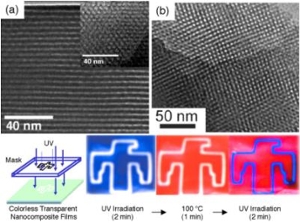 Using polymerizable surfactants as both structure directing agents and monomers, we have continued our investigation of nanostructured conjugated polymer (polydiacetylene)/silica nanocomposites that exhibit thermochromic, mechanochromic, and solvatochromic switching behavior of interest for sensors. Specifically we have discovered rapidly reversible thermochromic switching under some conditions and have self -assembled pure PDA nanostructures (prepared without silica) that show rapid reversible switching (thermo-, solvato-, mechano-) accompanied by phase transformations.These systems should provide insight as to how the silica hosts influence the molecular switching behaviors. We also prepared polyphenylenevinylene (PPV)/silica nanocomposites with hexagonal structures. We expect that nanostrucutring of conjugated polymers could improve their photoluminescent and electroluminescent quantum efficiencies.
Using polymerizable surfactants as both structure directing agents and monomers, we have continued our investigation of nanostructured conjugated polymer (polydiacetylene)/silica nanocomposites that exhibit thermochromic, mechanochromic, and solvatochromic switching behavior of interest for sensors. Specifically we have discovered rapidly reversible thermochromic switching under some conditions and have self -assembled pure PDA nanostructures (prepared without silica) that show rapid reversible switching (thermo-, solvato-, mechano-) accompanied by phase transformations.These systems should provide insight as to how the silica hosts influence the molecular switching behaviors. We also prepared polyphenylenevinylene (PPV)/silica nanocomposites with hexagonal structures. We expect that nanostrucutring of conjugated polymers could improve their photoluminescent and electroluminescent quantum efficiencies.
References:
Self-assembly of mesoscopically ordered chromatic polydiacetylene/silica nanocomposites. Lu, YF; Yang, Y; Sellinger, A; Lu, MC; Huang, JM; Fan, HY; Haddad, R; Lopez, G; Burns, AR; Sasaki, DY; et. al. NATURE; APR 19 2001; v.410, no.6831, p.913-917 Functional nanocomposites prepared by self-assembly and polymerization of diacetylene
Photoresponsive nanocomposite membranes for nanovalves
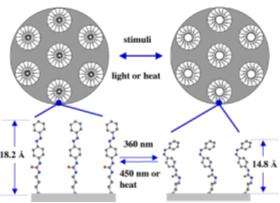 Incorporation of covalently-bonded, “switchable” azobenzene ligands as pendant groups within a porous framework is expected to result in nanocomposites with dynamically controllable pore size (Fig. 1), which is of particular interest for nanovalves ormolecuar gates with potential applications in smart gas masks, membranes, and controlled release as well as new types of externally-controlled micro/nanofluidic channel systems. Such photoresponsive thin film nanocomposites were fabricated by an EISA procedure using Brij56 as the structure-directing agent and TSUA (4-(3-triethoxysilylpropylureid)azobenzene) as the photoresponsive precursor. As determined using TEM and GISAXS techniques (Fig. 2), the photoresponsive nanocomposite membranes exhibited body-centered cubic mesostructure.
Incorporation of covalently-bonded, “switchable” azobenzene ligands as pendant groups within a porous framework is expected to result in nanocomposites with dynamically controllable pore size (Fig. 1), which is of particular interest for nanovalves ormolecuar gates with potential applications in smart gas masks, membranes, and controlled release as well as new types of externally-controlled micro/nanofluidic channel systems. Such photoresponsive thin film nanocomposites were fabricated by an EISA procedure using Brij56 as the structure-directing agent and TSUA (4-(3-triethoxysilylpropylureid)azobenzene) as the photoresponsive precursor. As determined using TEM and GISAXS techniques (Fig. 2), the photoresponsive nanocomposite membranes exhibited body-centered cubic mesostructure. 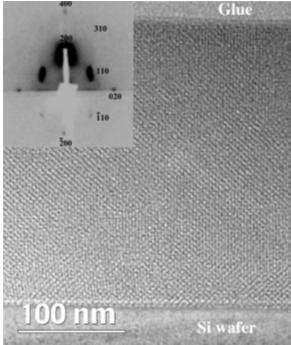 The size selective photoregulated mass transport of two ferrocene-based molecular probes (FDM and FDMDG) through the membrane to the electrode surface was determined using a chronoamperometry technique. The measured oxidative current increased and decreased in response to alternating UV and visible light exposure, which correlates strongly with the photoisomerization state of the azobenzene ligands (Fig. 3). This indicates that the optically switchable conformation (trans or cis) of azobenzene ligands controls the effective pore size, and, correspondingly, transport behavior on the nanoscale.
The size selective photoregulated mass transport of two ferrocene-based molecular probes (FDM and FDMDG) through the membrane to the electrode surface was determined using a chronoamperometry technique. The measured oxidative current increased and decreased in response to alternating UV and visible light exposure, which correlates strongly with the photoisomerization state of the azobenzene ligands (Fig. 3). This indicates that the optically switchable conformation (trans or cis) of azobenzene ligands controls the effective pore size, and, correspondingly, transport behavior on the nanoscale.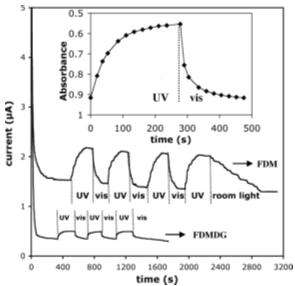
References:
Photoregulation of Mass Transport through a Photoresponsive Azobenzene-Modified Nanoporous Membrane, N. G. Liu, D.R. Dunphy, P. Atanassov, Scott D. Bunge, Z. Chen, G.P. López, Timothy J. Boyle, and C.J. Brinker,Nano Letters, 2004. 4(4): p. 551-554.
Photoresponsive Nanocomposite Formed by Self-Assembly of an Azobenzene-Modified Silane, N. G. Liu, Z. Chen, D.R. Dunphy, Y.-B. Jiang, R.A. Assink, and C.J. Brinker, Angew. Chem. Int. Ed., 2003. 42: p. 1731-1734.
Synthesis and crystallographic structures of a novel photoresponsive azobenzene-containing organosilane,N. G. Liu, D. R. Dunphy, M. A. Rodriguez, S. Singer, and C. J. Brinker, Chem. Comm., 2003: p. 1144-1145
Ion Channel Sensors
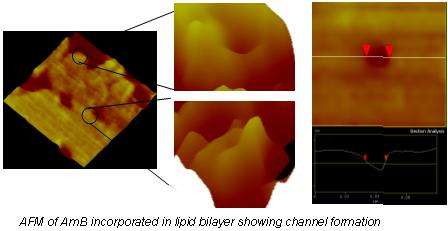 In order to understand transport in membrane supported ion channels, we have fabricated synthetic lipid bilayer with embedded ion channels on nanoporous silica support. AmB peptides form channels in bilayer system via self-assembly and provide a model system representing selectively permeable biological membranes with excellent gating mechanism. Our approach employed self-assembled, nanoporous silica films as a new type of lipid bilayer membrane support/interface im parting fluidity and durability by creating ionic reservoir akin to cytosol. These synthetic ion channel integrated with electronic platforms enable real time conversion of molecular recognition events into digitized/quantized electronic signals. We have investigated the influence of a nanoporous silica support on the ion channel structure and function by in -situ AFM ion and conductance recordings.
In order to understand transport in membrane supported ion channels, we have fabricated synthetic lipid bilayer with embedded ion channels on nanoporous silica support. AmB peptides form channels in bilayer system via self-assembly and provide a model system representing selectively permeable biological membranes with excellent gating mechanism. Our approach employed self-assembled, nanoporous silica films as a new type of lipid bilayer membrane support/interface im parting fluidity and durability by creating ionic reservoir akin to cytosol. These synthetic ion channel integrated with electronic platforms enable real time conversion of molecular recognition events into digitized/quantized electronic signals. We have investigated the influence of a nanoporous silica support on the ion channel structure and function by in -situ AFM ion and conductance recordings.
Super-hydrophobic Surfaces
It is well observed in na ture that to achieve surfaces with high hydrophobicity, proper surface roughness is required in combination with correct surface chemistries. Presently we are studying the optimum surface roughness required for highest contact angle and lowest rolling angle. We are preparing ultra-hydrophobic organo-silica films using a sol-gel process. We have visually identified self-cleaning action and bouncing of the liquid drops on ultra-hydrophobic aerogel materials.
Nanostructured molecular sieve membranes
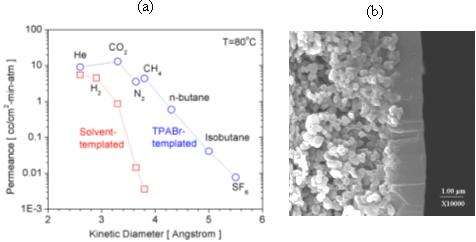 Our membrane research program is focused on the synthesis of microporous and mesoporous silica- based molecular sieve films that can find application as permselective or support layers in membrane composites aiming gas, vapor and liquid separations. Examples of current research include development of microporous aminosilicate membranes for enhanced CO2/air separation, organic-templated silica membranes that can mimic the separation function of zeolite membranes, and nanostructured palladium/mesoporous silica composites for enhanced H2 separation. In the area of mesoporous films, work is underway to develop silica-based surfactant-templated layers on coarse-pore ceramic or metallic substrates, in order to facilitate deposition of a zeolite-or palladium-based gas separation membrane for H2 purification.
Our membrane research program is focused on the synthesis of microporous and mesoporous silica- based molecular sieve films that can find application as permselective or support layers in membrane composites aiming gas, vapor and liquid separations. Examples of current research include development of microporous aminosilicate membranes for enhanced CO2/air separation, organic-templated silica membranes that can mimic the separation function of zeolite membranes, and nanostructured palladium/mesoporous silica composites for enhanced H2 separation. In the area of mesoporous films, work is underway to develop silica-based surfactant-templated layers on coarse-pore ceramic or metallic substrates, in order to facilitate deposition of a zeolite-or palladium-based gas separation membrane for H2 purification.
Mesoporous Micro-and Nano-particles prepared by
Evaporation-Induced Self Assembly within Aerosols
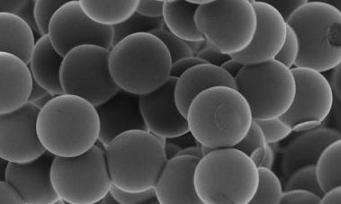 Evaporation induced self assembly (EISA) within microdroplets produced by a vibrating orifice aerosol generator (VOAG) has been used to produce monodisperse mesoporous silica particles. This process exploits the concentration of evaporating droplets to induce the organization of various amphiphilic molecules, effectively partitioning the silica precursor (TEOS) to the hydrophilic regions of the structure. Promotion of silica condensation, followed by removal of the surfactant, provides ordered spherical mesoporous particles. Using the VOAG, we have produced highly monodisperse particles in the 5 to 10 μm diameter range. The cationic surfactant CTAB typically leads to hexagonal mesostructure with mean pore size of about 2 nm and specific surface area around 900 m2/g. We have also shown that the pore size in CTAB-templated particles can be increased to 3.8 nm by incorporating trimethylbenzene as a swelling agent. The TMB preferentially locates inside and swells the hydrophobic regions of the surfactant mesostructure. Pore size can also be varied by the choice of amphiphile.
Evaporation induced self assembly (EISA) within microdroplets produced by a vibrating orifice aerosol generator (VOAG) has been used to produce monodisperse mesoporous silica particles. This process exploits the concentration of evaporating droplets to induce the organization of various amphiphilic molecules, effectively partitioning the silica precursor (TEOS) to the hydrophilic regions of the structure. Promotion of silica condensation, followed by removal of the surfactant, provides ordered spherical mesoporous particles. Using the VOAG, we have produced highly monodisperse particles in the 5 to 10 μm diameter range. The cationic surfactant CTAB typically leads to hexagonal mesostructure with mean pore size of about 2 nm and specific surface area around 900 m2/g. We have also shown that the pore size in CTAB-templated particles can be increased to 3.8 nm by incorporating trimethylbenzene as a swelling agent. The TMB preferentially locates inside and swells the hydrophobic regions of the surfactant mesostructure. Pore size can also be varied by the choice of amphiphile. 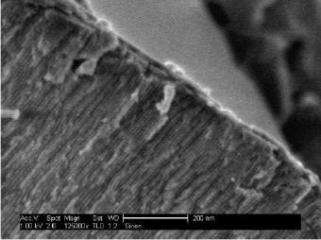 Hexagonally ordered particles have been produced using the nonionic surfactant Brij-58 and block copolymer F127. These powderspossessed mean pore size 2.8 nm and 6.9 nm, respectively. The uptake of alkyl pyridinium chloride molecules have recently been measured, revealing an uptake capacity that is explained by surface adsorption (as opposed to simple pore infiltration). Kinetics of the uptake process are still be analyzed.
Hexagonally ordered particles have been produced using the nonionic surfactant Brij-58 and block copolymer F127. These powderspossessed mean pore size 2.8 nm and 6.9 nm, respectively. The uptake of alkyl pyridinium chloride molecules have recently been measured, revealing an uptake capacity that is explained by surface adsorption (as opposed to simple pore infiltration). Kinetics of the uptake process are still be analyzed.
References:Monodisperse Mesoporous Microparticles Prepared by Evaporation-Induced Self-Assembly Within Aerosols. Rathod, SB; et. al., MAT. RES. SOC. SYMP. PROC.; 2003; v.775, p. P1.11.1-P.1.11.6
Synthesis and Characterization of Germanium Nanocrystals
Research topics in this area include solution synthesis and characterization of germanium nanocrystals (GeNCs), self-assembly of GeNCs and plasma etching. Application of GeNCs covers optoelectronics, non-linear optics and sensors. However, germanium nanocrystals have not been widely used as other compound semiconductor due to the difficulty of synthesis. The covalent bond nature of group IV semiconductor requires high pressure and temperature to synthesize nanocrystals, which hinders further application of these materials.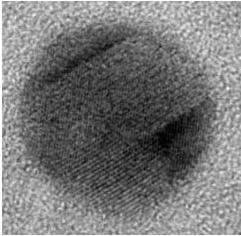
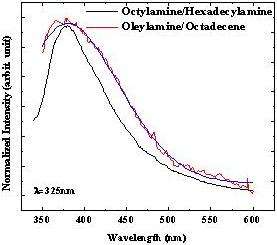
We have developed a novel method to synthesize GeNCs in solution at ambient pressure and relatively low temperature. The resulting GeNCs can be stabilized in different type of ligands. Upon excitation with visible wavelength laser, a photoluminescence effect is observed. This indicates the presence of quantum confinement effect, which is attributed to large Bohr exciton radius of GeNCs.
Current works include characterization of GeNCs and an in depth study of the effect of different ligands.
Nanoporous silica composite material for corrosion
inhibition of aluminum alloys
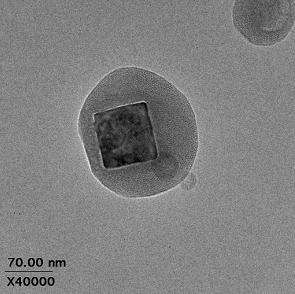 Environmentally resistant corrosion inhibitor coatings are required to ensure the reliability and long-term durability of metallic alloys. Composite silica particles are a potential cost-saving candidate to replace current technology. The internal pore structure of these particles may be engineered to impart controlled release properties. Pore structure, inhibitor distribution, and surface chemistry influence transport from the pore to the outer particle surface. Our aim is to develop silica composite parti cles with suitable structures and to investigate the fundamental mechanisms in the configurational transport of inhibitors. A mathematical model is expected to describe the transport behavior.
Environmentally resistant corrosion inhibitor coatings are required to ensure the reliability and long-term durability of metallic alloys. Composite silica particles are a potential cost-saving candidate to replace current technology. The internal pore structure of these particles may be engineered to impart controlled release properties. Pore structure, inhibitor distribution, and surface chemistry influence transport from the pore to the outer particle surface. Our aim is to develop silica composite parti cles with suitable structures and to investigate the fundamental mechanisms in the configurational transport of inhibitors. A mathematical model is expected to describe the transport behavior.
